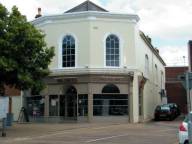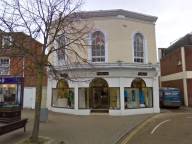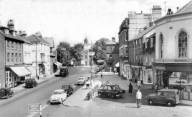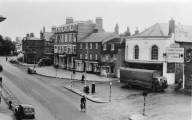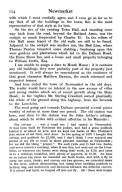No.29 High Street
Wildwood, Italian Restaurant
Shop History
|
2012 - |
Wildwood, Italian Restaurant |
|
|
2008 - |
Anne Furbank |
|
|
1978 - |
Jane of Newmarket - womens' fashion |
|
|
Abt. 1960 - 1974 |
Gas Service Showroom |
|
|
12th June 1953 |
Gas Office |
|
|
1936 |
Old Town Hall buildings: |
|
|
1926 |
Newmarket Town Hall Buildings: |
|
|
1925 |
Newmarket Gas Co. (The); show rooms, Town Hall Buildings, High Street - Kelly's Directory |
|
|
1924 |
Newmarket Gas Co. |
|
|
1923 |
Town Hall |
|
|
1916 |
Town Hall, High Street, Sidney J. Ennion, |
|
|
2nd Apr 1911 |
Town Hall: James Woollard, Gardener - Census |
|
|
1901 |
Town Hall: John Manning, Painter - Census |
|
|
1891 |
Public Hall: Charles Jebb, Retired Jockey (In 1861, 15yo Charles was a stable boy for trainer William Channell in Newmarket.) |
|
|
1855 |
Public Hall - White's Directory |
|
|
1851 |
Theatre, High Street - Gardner's Directory |
|
|
11th Nov 1826 - |
Fisher Theatre |
|
|
Medieval Cock Pit |
Notes
-
This building has a long a varied history; for many years it was
Jane's womens' fashion shop and then prior to that it had been the Gas
Service showroom. Further details about this history are given below.
-
Jane shuts up shop after 40 years - ONE of Newmarket's leading fashion
shops is to close in August:-
 http://www.newmarketjournal.co.uk/news/latest-news/jane-shuts-up-shop-after-40-years-1-546318
http://www.newmarketjournal.co.uk/news/latest-news/jane-shuts-up-shop-after-40-years-1-546318
-
The Town Hall
-
Opening in the early 1850s as a public hall it later became known as the Town Hall.
Described in White's Directory of 1874:- 'The Theatre has been converted into a commodious Public Hall, used for public meetings, lectures, assemblies, concerts &c.'
In 1907 the hall while being used as a cinema by Gaumont, during a showing, the unenclosed limelight projector was accidentally upset and ignited the celluloid film. This lead to a major fire in which 300 people were injured and three died of burns. (see below for details)
This and several other tragedies eventually led to the passing of the Cinematograph Act of 1909.
Friday 13th September 1907, Lichfield Mercury, Staffordshire PANIC AT A BIOGRAPH ENTERTAINMENT. PEOPLE INJURED.
A dangerous panic occurred at a biograph entertainment the Town Hall, Newmarket, on Saturday night. [7th September 1907]
The apparatus burst into flames, and the audience made a rush for the doors, where for a quarter of an hour terrified mass of people was wedged in a frantic endeavour to escape.
Several of those sitting near the apparatus had their clothing ignited. Fortunately these were got out of the building before the worst the rush came.
The fire was caused apparatus being overturned people leaving during the interval by the main entrance, close to which the machine was fixed.
The escaping gases ignited one of the films, and flames quickly arose. These were seen the crowded hall, and a cry of Fire was raised, and a panic ensued.
The captain of the Newmarket Town Fire Brigade, Mr. Frank Simpson, was, by a happy circumstance, among the audience, and he promptly connected the hall hose with the main and played upon the fire.
Meanwhile the manager, Mr. E. Court, ran out of the hall carrying the blazing film, and the operator turned off the escaping gas, the fire being quickly got under control.
The struggle to get out of the building many people were injured. Several persons were taken the hospital.
A young married woman named Starling died on Sunday morning in the Rous Memorial Hospital, Newmarket, from burns about the body, incurred during the fire on Saturday night. Her clothing was burned to cinders.
Clara Ashby, dom servant, suffered terrible burns, being practically blinded, and another girl, Martha Draffin, was also seriously injured, the condition of both on Sunday evening being considered so serious that fatal results are feared.
Henry Jellis, light weight jockey, belonging to Tom Jennings training establishment, is also detained in the hospital with his hands burned, but his condition fairly satisfactory.
It is believed that quite three hundred persons are suffering from burns, bruises, and shock, and the doctors have attended cases all over the town. Many had their wounds dressed at the hospital and were discharged.
After the fire had been extinguished the mad rush to leave the hall continued, and a police sergeant and constable saved many people from serious injury - dragging fainting and hysterical women and children out of the door and handing them to the crowd outside, while other helpers rescued the imprisoned through the windows or through openings elsewhere.
Many left portions of their apparel behind them in their anxiety. The police afterwards found a quantity of jewellery, most of which has since been claimed.
-
A detailed report about this tragedy can be read on the following page
from the Newmarket Journal:-
 http://www.newmarketjournal.co.uk/news/latest-news/the-night-when-tragedy-struck-1-545039
http://www.newmarketjournal.co.uk/news/latest-news/the-night-when-tragedy-struck-1-545039
-
Details about the jockey Henri Jelliss can be found on the page about Glenwood,
where he lived in 1923.
-
The Fisher Theatre
- The building was in use in 1823 as of one of David Fisher's circuit
playhouses, a company that performed in and around East Anglia at
that time.
They later acquired the land and built a new theatre on the site which opened on 11th November 1826.
The building later ceased to be a theatre in the early 1850s and was converted to the public hall detailed above.
-
The Cock-pit
-
Extending over a slightly larger area than the existing building the site had previously been used as a cock-pit and notably a 'Royal' cock-pit, having had royal patronage from as early as Charles I's time at Newmarket in the early 1600s. At these times cock-fighting rivaled the popularity of horse-racing in Newmarket and reading through various accounts it seems that it was possibly considered more entertaining and important.
-
The above book statement that there were no 'seventeenth-century
views of a the interior of a cock-pit' was clearly made without the
present-day wider access to historic documents - as you can see
below in a contemporary sketch of King Charles I by dutch artist
Anthony Vandyke (1599-1641), from the book 'Sporting and Rural Records of the Cheveley Estate'
by J.P. Hore.
-
Further details about the cockpit and the Fisher theatre can be found on the
Newmarket Local History Society web site:-
(scroll down the linked page to find the following article)
August 4th 2005. From Ivy Collins following information we had sent her about Newmarket's Fisher Theatre ....
 http://www.newmarketlhs.org.uk/nlhscorrespondence4.htm
http://www.newmarketlhs.org.uk/nlhscorrespondence4.htm
- Due to various events cock-fighting started to wane in popularity in
the UK from the early 1800s; in 1835 parliament passed 'An Act to consolidate
and amend the several laws relating to the cruel and improper
Treatment of Animals' - not specifically aimed at cock-fighting it
restricted the places where fights could be held; coupled with
disreputable gambling practises in the sport; and the 1849 'Cruelty to
Animals Act' pretty much ran the sport out of the public arenas.
Cock-fighting - once the 'sport of kings', that title has transferred to Newmarket's other main event - horse-racing.
- Other places in Newmarket that had cock-pits are the Bushel
Inn, where it's reported that there's evidence of a cock-pit in
the cellar and 'Shagbag Alley', now Sackville Street (note the terms
'Shagbag' and 'Shake-bag' are synonymous).
It's been defined elsewhere that Shagbag was the bag that the cock was kept in before the fight, but this isn't quite correct as Bart. Sir Walter Gilbey's book about the 'History of Cockfighting' details:-
"SHAKE-BAGS" Only the very large "the giant or Herculean" cock was called a "shake-bag" in Queen Anne's time. According to Dr. Wilde, a famous cocker of the age, the name originated in Scotland, being used to describe the cocks preferred by Dutchmen. The Dutch preference for large birds was due to the fact that they could be fought without weighing or matching at any inn or drinking resort ; the Dutchman's habit was to "steep his brains in brandy" till he was past judging of a cock's size, and past handling him. These cockers neither saw the cock they were to fight with beforehand, nor laid a hand upon their own after he was brought into the pit, "but take the bag by the bottom and shake the cock out upon the pit and so let him go at his adversary".
At a later date the term 'Shake-bag' acquired more definite meaning, being applied to cocks which exceeded 4 lbs. 8 ozs. in weight. Gilbey's book explains that the more refined cock-fighter preferred smaller birds as they fought more voraciously, but that these Shake-bags were mostly used in the lower class pits that most probably existed in Shagbag Alley, as they fought with just shear brute force and being large and unwieldy birds they had to be shaken from the bag to begin the fight - hence the name.
- English Heritage Listed Building Details:-
http://www.britishlistedbuildings.co.uk/en-275670-29-high-street-newmarket-suffolk
Building Changes
- Suffolk Record Office, Bury St Edmunds Branch
Newmarket Urban District Council Records -
Reference EF 506
Correspondence, papers, plans, abstract of title (1825-1829) and
duplicate conveyance relating to sale of the old Town Hall formerly
used as a cinema and theatre EF 506/3/155 1907 - 1923
Contents: Papers include Urban District Council regulations for use of cinematograph lanterns etc. in Town Hall, 1908 - Alterations, Old Town Hall, Rutland Hill, for Newmarket Gas Co
(Holland & Sons) EF 506/6/1/19/678 May
1924
-
Planning Application - F/2012/0412/LBC
Ann Furbank Ltd 29 High Street Newmarket
Application Registered 24-07-2012
Internal alteration which include erection of partition walls, demolition of existing walls, installation of mechanical plant and ducting, raise part of floor at 1st floor level and kitchen area. External alterations: Replace some of the existing windows with louvres.
-
Planning Application - F/2012/0410/COU
Ann Furbank Ltd 29 High Street Newmarket
Application Registered 23-07-2012
Change of use from A1 retail to A3 bar/restaurant
-
Planning Application - F/77/609
29 High Street Newmarket Suffolk
Application Registered 24-10-1977
New shop front
- Many thanks to 'Old Newmarket' for the photos 'Gas Service Showroom c. 1960' and 'The Town Hall c. 1950s'.
|
'Sport in the Olden Time'
(History of Cockfighting Series) by Sir Walter Gilbey, Bart., 1912 |
 |
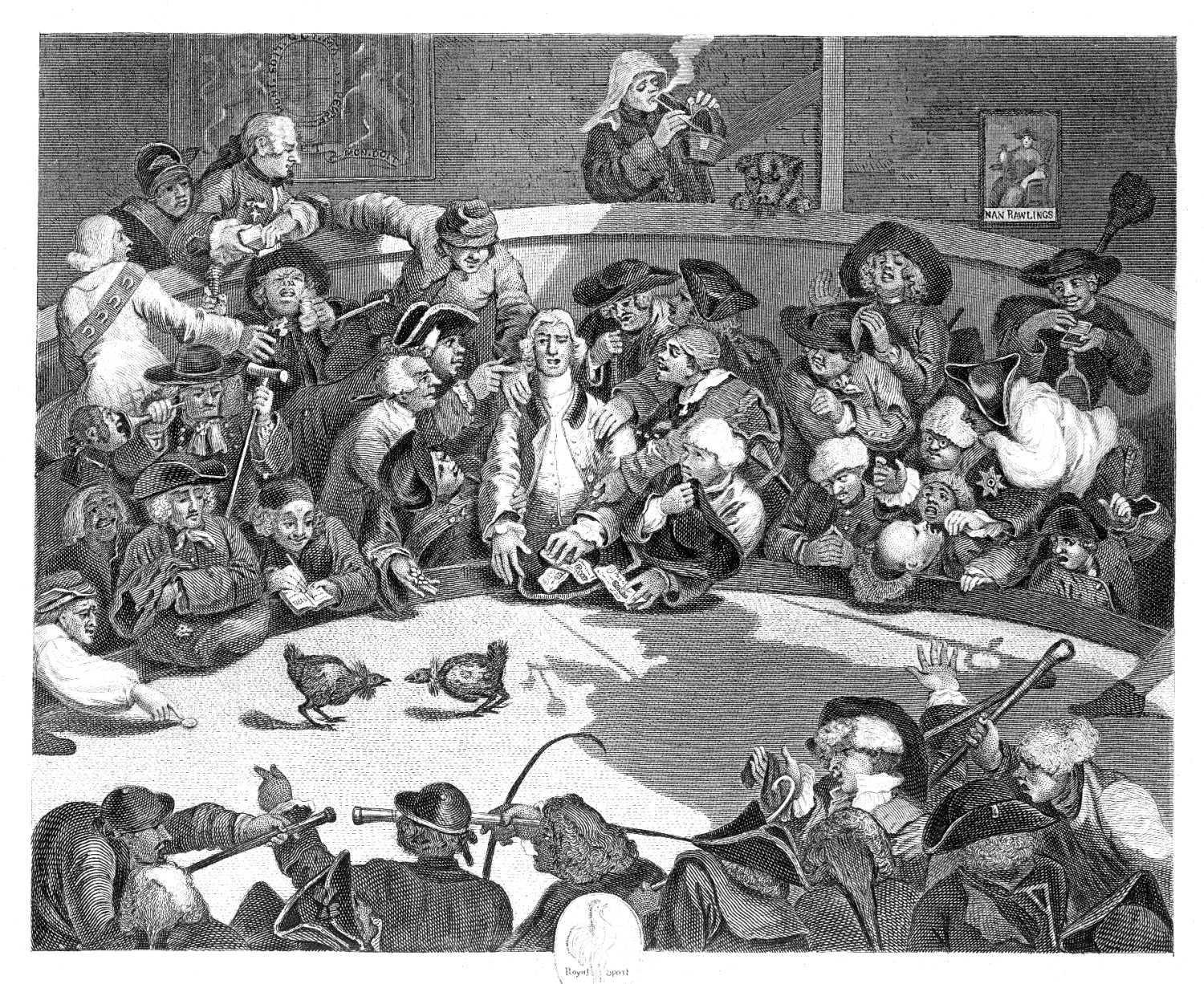 The Cockpit Royal Engraving - William Hogarth - 5th November 1759 |
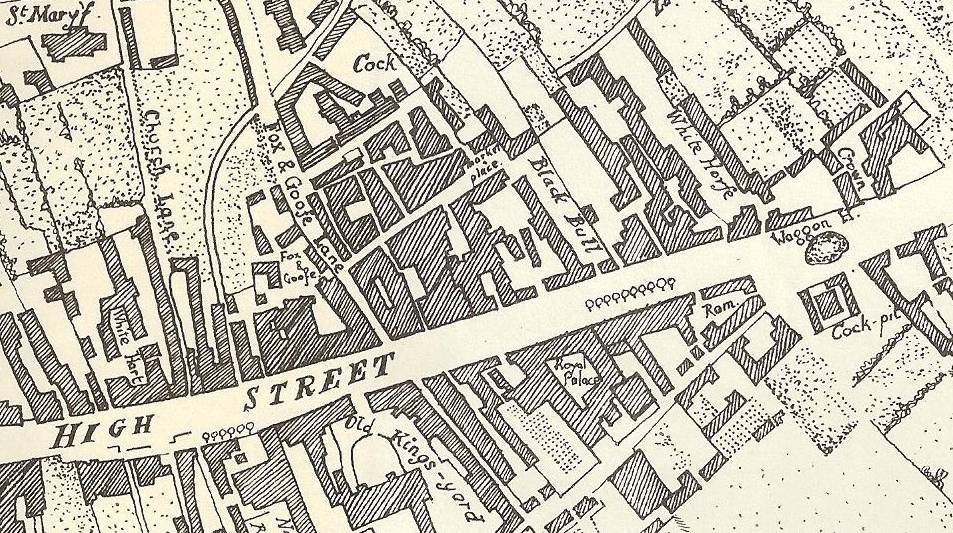 Chapman's Map of Newmarket 1787 |
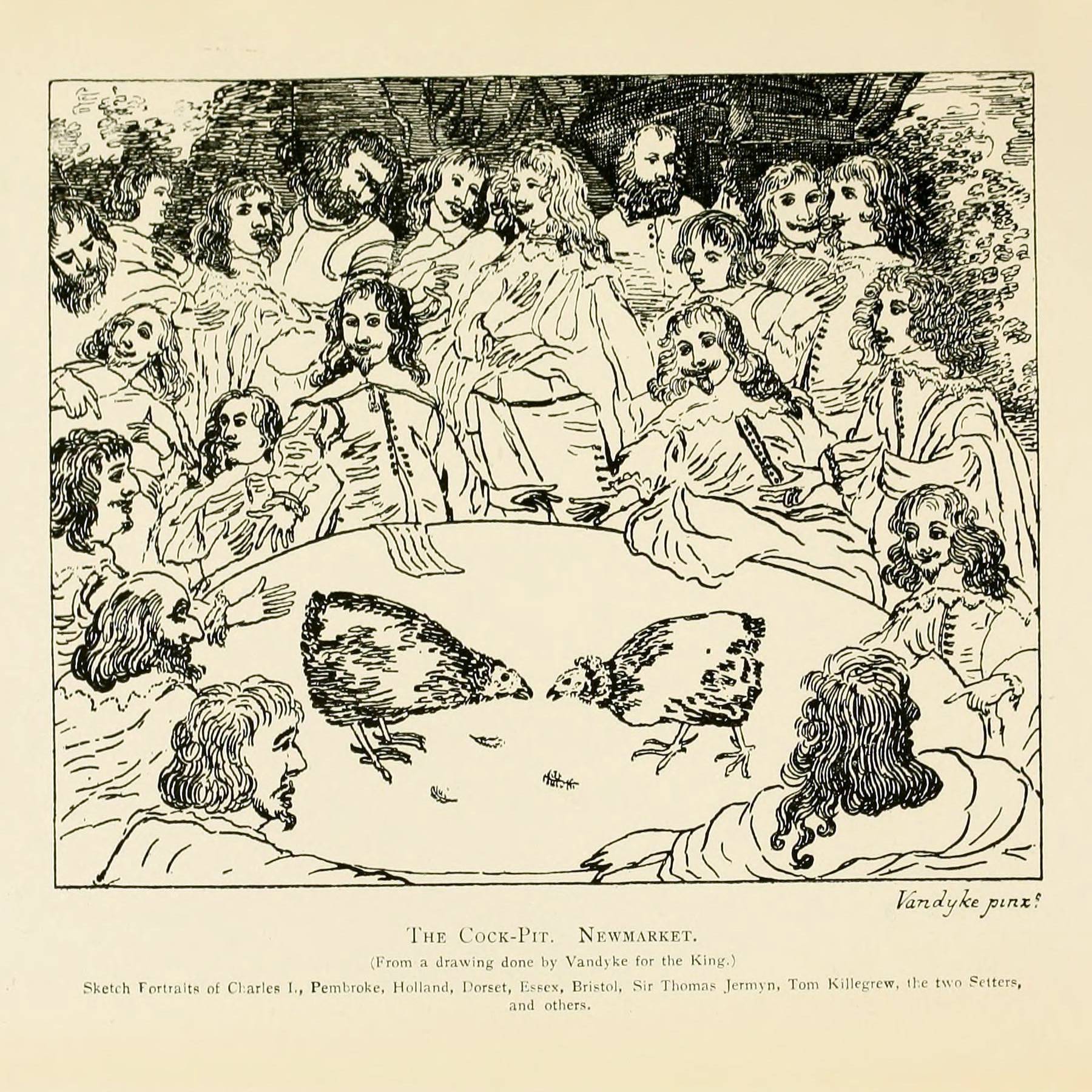 The Cock-Pit Newmarket - showing Charles I and others - Vandyke |
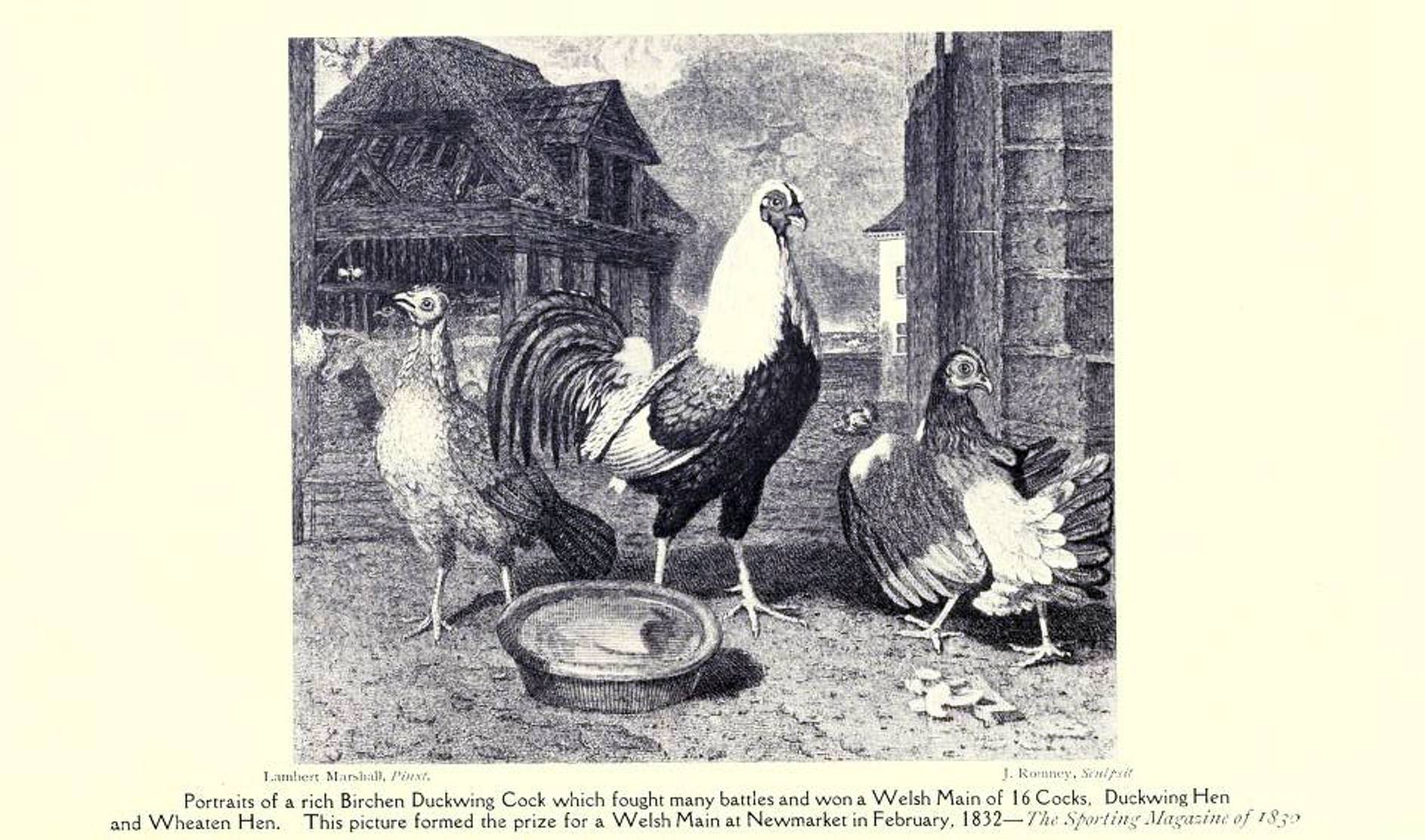 |
| Newmarket: its sports and personalities by Frank Silzter. Published 1923 '... On the site of the existing Town Hall, and standing some way back from the road, beyond the Rutland Arms, was the cockpit so much frequented by Charles II. In the cellars of this Hall some traces of the old walls are still to be found. Adjacent to the cockpit was another inn, the Red Lion, where Thomas Panton tenanted some stabling; bordering upon this were gardens and plantations which led to the Dalham Road, the Horse Shoes Inn, and a house and small property belonging to William Crofts, Esq. I am unable to assign a date to Heath House; if it contains any old buildings, they were probably part of the property just mentioned. |
(See below for this article on page 114 from 'Newmarket its sports & personalities'.)
| 29, High
Street Grade: II Date Listed: 26 June 1984 English Heritage Building ID: 275670 |
